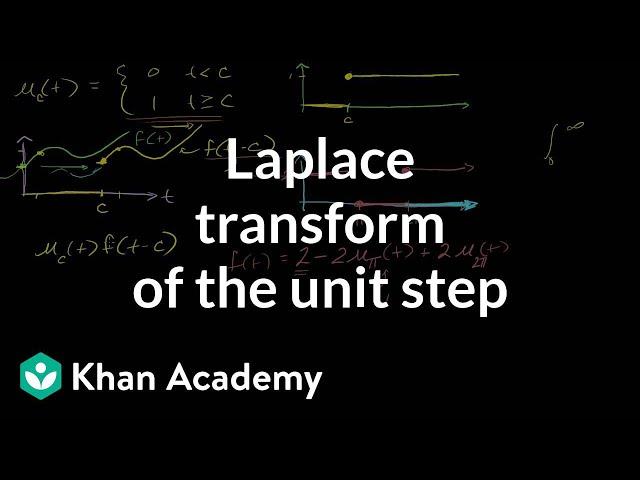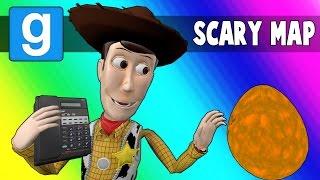
Laplace transform of the unit step function | Laplace transform | Khan Academy
Комментарии:

It's like you taught Laplace how to use his Transform !!!!!!!!!!!!!
Ответить
Thank you!
Ответить
this is an absolutely amazing explanation!!....but why do we shift the function to the right and multiply it by unit step function, what is the purpose of that?
Ответить
I love your old math videos ! Best explanation ever ! It's pity you don't record it anymore.
Ответить
I'm stuck Step Function 😬😬🤭
Ответить
Hi Hello👋👋
Ответить
Mr Sal I love your work, in this video I kinda disagree with how u simplified Laplace of the step function, u replaced x=t at the end but we know that X=t+c please help me out here
Ответить
* Thanks a lot, for introducing this new -- (shifted) "unit step function"
* shifted is my own annotation, as i think μ_zero or just μ is a more fundamental function, with the general μ_c being shifted to right by +c i.e. the μ( t - c )
Anyways:
* this step fxn eases alot the task of defining functions which are stepped at only a few (say 1-3) points like the fxns for absolute, or signum, or other such
* eases a lot - or at least provides a new way to think about ...
* other than that, i don't think it helps much for other periodically partwise functions like floor, ceiling, fractional-part, modulus, remainder, etc.

Thanks mate keep going even if you upload it when i was just learning multiplication
Ответить
Why do I have to watch these videos to complete my homework? Where is my school's lectures???
Ответить
Isn't it discontinuous at t equals c?
Ответить
Thanks a lot.
Ответить
i didnt understand
Ответить
Sir, You are a lifesaver. I salute you, Bro.
Ответить
Can anyone explain the missing step of how f(t-c) = f(t) ??? I was following this course with no problems up until this point. It clearly confused a lot of other people too.
Ответить
Jesus this was explained 34217923489231749872384293741982373982x better than how my DE professor explained it.
Ответить
Its amazing how you and my professor teach the same exact thing but with you it just magically makes SO MUCH SENSE!
Ответить
Thank you 😃
Ответить
❤️
Ответить
Are we assuming c>0?
Ответить
Sir kindly explain in white board instead this.
Ответить
"difFRENtial equations "
Ответить
ur a crazy person,ur not saying unit step function instead saying second shifting property thereom in laplace........ dont watch this video
Ответить
You are actually using Latin alphabet :D
Ответить
x is the most fun variable, stay away from crazy latin alphabets
Ответить
L{f(y) } if l putting e-sy ?
Ответить
my hero
Ответить
YOU ARE AMAZING
Ответить
you are runing out of ink
Ответить
Why is the laplace of f(x) = laplace f(t) when x = t-c ? Why does that seem wrong to me?
Ответить
This helped more than a gruelling hour long lecture in college
Ответить
what if i have both are unit step function instead of f of t... i thought i almost done but then my question slightly different
Ответить
I want to to take the laplace transform of a heaviside function, how come i have to be lectured for 24 min? This is a 5 min tops video.
Ответить
I DONT UNDERSTAND
How you said L(x) is same as L(t) when you substituted x=t - c

Awsummm Workkkk Sir, U know What Our Instructor Was Doing these things, Like things Are moving In air , But u Did, Insert those Concepts For What I was Thinking Thnx Again
Ответить
Hi Sal
Thanks for the videos, could you please explain how did you assume F(X) is equal to F(t) in the end of the video because earlier you said x = t-c ?
Thanks again.

did u mean that unit step function is used to obtain equation for change in wave form?
Ответить
1 no.
Ответить
A super Duper help to me , thank you from the bottom of my heart :)
Ответить
Why is the laplace transform L{u(t)f(t-c)} equal to e^(-cs)*L{f(t)} where f(t) is the unshifted function and not equal to e^(-cs)*L{f(t-c)} where f(t-c) is the shifted function? When you worked out the integral with the variable x, you got as an answer that L{u(t)f(t-c)}=e^(-cs)*L{f(x)} and since x=t-c, shouldn't L{u(t)f(t-c)}, when you substitute (t-c) back for x, be equal to e^(-cs)*L{f(t-c)} instead of e^(-cs)*L{f(t)}?
Ответить
My DE's textbook, (Trench) uses these fucken insane latin alphabets with laplace and it pisses me off. This is much better, thank you :)
Ответить

























